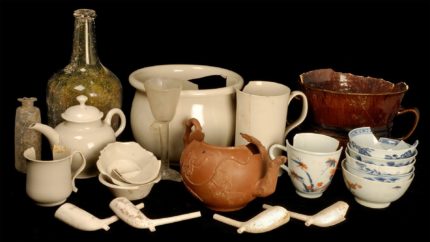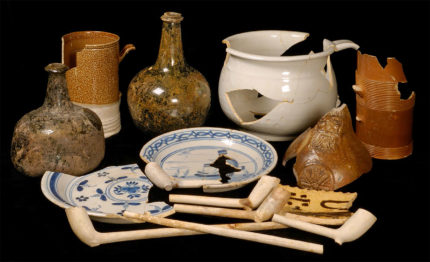
The building changed hands and was in-filled. Soon Clapham’s was forgotten and the one-time hotspot was left in the cold until the 21st century when Cambridge University’s St John’s College called in archaeologists to survey the area of its Old Divinity School and a cellar was found off All Saints’ Passage that had hundreds of 18th century coffeehouse artifacts. The excavations were completed in 2012. In the final accounting, archaeologists recovered more than 500 objects, several of which provided clear evidence of their former owners.
Some of the items found were still clearly marked with William and Jane’s initials. They included tea bowls (the standard vessel for drinking tea at the time), saucers, coffee cans and cups, and chocolate cups – which the researchers were able to distinguish because they were taller, since “chocolate was served with a frothy, foamy head”. They also found sugar bowls, milk and cream jugs, mixing bowls, storage jars, plates, bowls, serving dishes, sauceboats, and many other objects.
Even though Clapham’s was a coffeehouse, the finds suggest that tea was fast winning greater affection among drinkers; tea bowls were almost three times as common as coffee cans or cups.
Perhaps more striking, however, was the substantial collection of tankards, wine bottles and glasses, indicating that alcohol consumption was normal. Some drinkers appear to have had favourite tankards reserved for their personal use, while the team also found two-handled cups, possibly for drinking “possets” – milk curdled with wine or ale, and often spiced.
Compared with the sandwiches and muffins on offer in coffee shops today, dining was a much bigger part of life at Clapham’s. Utensils and crockery were found for making patties, pastries, tarts, jellies, syllabubs and other desserts. Animal bones revealed that patrons enjoyed shoulders and legs of mutton, beef, pork, hare, rabbit, chicken and goose. The researchers also found oyster shells, and bones from fish such as eel, herring and mackerel.
This sensational find gave researchers the chance to do the first comprehensive study of artifacts from a single, identifiable 18th century coffeehouse. Being able to develop a thorough understanding of the history one specific coffeehouse by examining its material culture is important because you don’t have to rely solely on period sources written sources which could be any combination of incorrect, incomplete, incompetent, ignorant, one-sided, lying, etc.
Although coffeehouses have traditionally been associated with the increasing popularity of smoking in Britain, there was little evidence of much at Clapham’s. Just five clay pipes were found, including one particularly impressive specimen which carries the slogan “PARKER for ever, Huzzah” – possibly referring to the naval Captain Peter Parker, who was celebrated for his actions during the American War of Independence. The lack of pipes may be because, at the time, tobacco was considered less fashionable than snuff.
Together, the assemblage adds up to a picture in which, rather than making short visits to catch up on the news and engage in polite conversation, customers often settled in for the evening at an establishment that offered them not just hot beverages, but beer, wine, punch and liqueurs, as well as extensive meals. Some even seem to have “ordered out” from nearby inns if their favourite food was not on the menu.
There was little evidence, too, that they read newspapers and pamphlets, the rise of which historians also link to coffeehouses. Newspapers were perishable and therefore unlikely to survive in the archaeological record, but the researchers also point out that other evidence of reading – such as book clasps – has been found on the site of inns nearby, while it is absent here.
“We need to remember this was just one of thousands of coffeehouses and Clapham’s may have been atypical in some ways,” Cessford added. “Despite this it does give us a clearer sense than we’ve ever had before of what these places were like, and a tentative blueprint for spotting the traces of other coffeehouse sites in archaeological assemblages in the future.”
Their first research paper on the find. the excellently named “To Clapham’s I go,” has just been published in the journal Post-Medieval Archaeology
